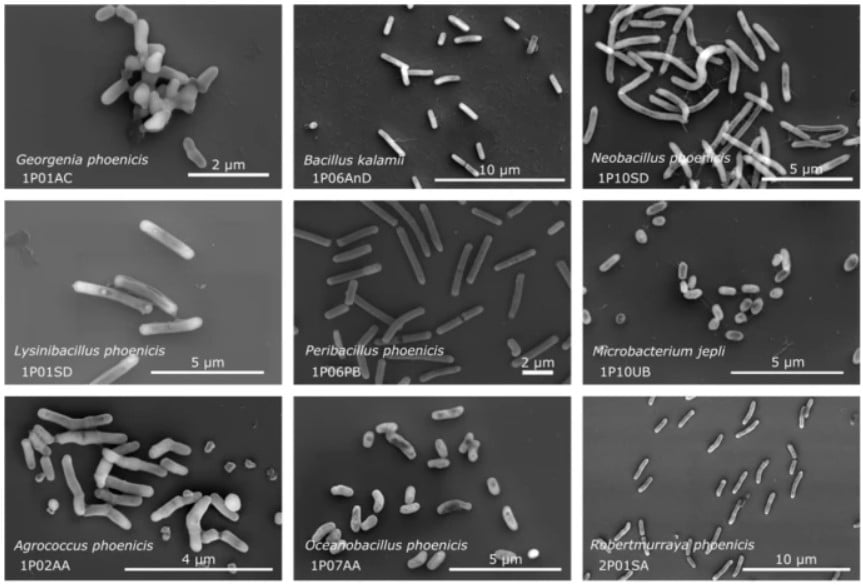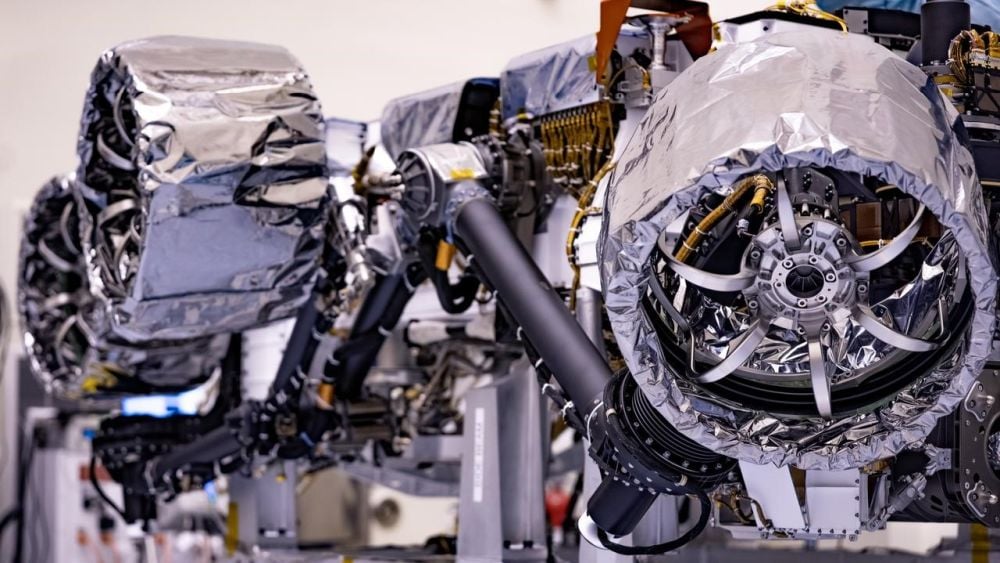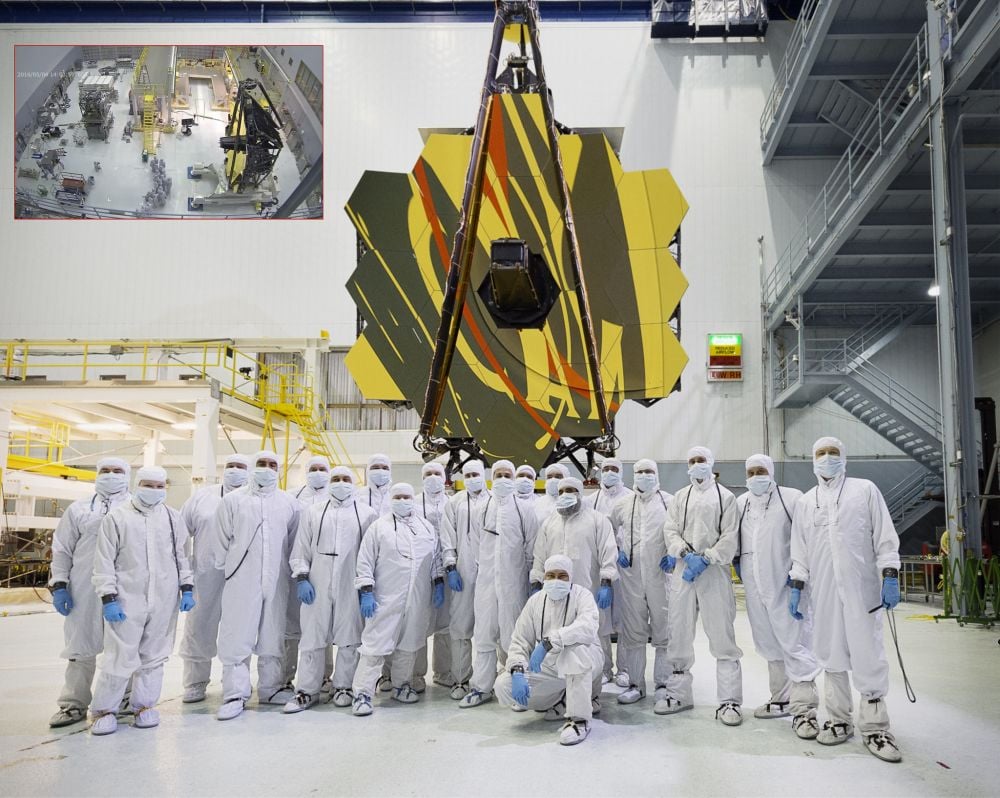Spacecraft are expensive and intricately engineered machines designed to perform complex missions in harsh space environments. They're costly and require a long time to design and build. Due to their uniqueness and high value, and the need to keep them sterilized, they're assembled in clean rooms that limit the amount of dust and microbes. New research shows that microbes are adapting to these clean rooms and learning how to thrive in them.
The research published in Microbiome shows that 26 novel species of extremophiles have adapted to the stringent conditions inside NASA cleanrooms. Cleanrooms are designed to inhibit bacteria with tightly regulated airflow, temperature, and humidity. These newly described organisms have genetic traits linked to surviving the extreme environments in space.
The research is "Genomic insights into novel extremotolerant bacteria isolated from the NASA Phoenix mission spacecraft assembly cleanrooms." The lead author is Júnia Schultz from the Biological and Environmental Science and Engineering Division at the King Abdullah University of Science and Technology in Saudi Arabia.
"Our study aimed to understand the risk of extremophiles being transferred in space missions and to identify which microorganisms might survive the harsh conditions of space." - Professor Alexandre Rosado, KAUST
The presence of microorganisms in cleanrooms isn't a surprise. While these rooms are designed to minimize their presence, life is extraordinarily resilient. Microorganisms are waiting to pounce on any nutrient, however scant, and form a biofilm.
This research is based on the cleanroom for NASA's Mars Phoenix mission, which landed on Mars in 2008. "During the Phoenix spacecraft mission, genomes of 215 bacterial isolates were sequenced and based on overall genome-related indices, 53 strains belonging to 26 novel species were recognized," the researchers explain in their research article.
Deeper examination of the genomes revealed that many of the new species had genes that bolstered resistance to decontamination and radiation. These are the descendants of the original population from the Phoenix cleanroom, which have been shaped by the conditions inside the cleanroom.
"Human-designed oligotrophic environments, such as cleanrooms, harbour unique microbial communities shaped by selective pressures like temperature, humidity, nutrient availability, cleaning reagents, and radiation," the authors write. "Even with stringent controls such as regulated airflow, temperature management, and rigorous cleaning, resilient microorganisms can persist in these environments, posing potential risks for space missions."
 These images from the research show nine of the extremophiles that thrive in a NASA cleanroom. Image Credit: Schultz et al. 2025, Microbiome.
These images from the research show nine of the extremophiles that thrive in a NASA cleanroom. Image Credit: Schultz et al. 2025, Microbiome.
There's a risk that one of our spacecraft could contaminate another world with terrestrial microbes adapted to extreme environments. Space agencies take this risk seriously for obvious reasons. If a planet like Mars were contaminated with Earth life, how would we ever know if we had found Martian life? The non-contamination of other worlds should be a basic tenet guiding our species' efforts to explore the Solar System and understand how things came to be.
There's a non-zero risk that even our best efforts could inadvertently contaminate another world with Earth life.
"Our study aimed to understand the risk of extremophiles being transferred in space missions and to identify which microorganisms might survive the harsh conditions of space. This effort is pivotal for monitoring the risk of microbial contamination and safeguarding against unintentional colonization of exploring planets," explained Professor Alexandre Rosado from the King Abdullah University of Science and Technology (KAUST). Rosado is the lead KAUST researcher on the project and a contributor to several NASA working groups on planetary protection and space microbiology.
The researchers found that many of the new microorganisms have genes that make them more resilient to radiation and decontamination. Clean rooms have strict cleaning protocols involving toxic compounds like isopropyl alcohol, which is quick and effective against many microorganisms.
"Further analysis of these organisms from the Phoenix spacecraft mission revealed that, on average, they possessed 74 genes predicted for defence mechanisms, primarily related to resistance to antibiotics and toxic compounds, and invasion and intracellular resistance," the authors write. Other genes are associated with improved metabolism and the detoxification of damaging molecules.
While not used to sterilize the entire space, clean rooms sometimes employ UV radiation to disinfect the air. UV radiation can damage DNA and RNA in bacteria, fungi, and viruses. Some of the identified genes are associated with DNA repair.
The researchers found that some of the new microorganisms had genes linked to survival in harsh space environments, including powerful UV radiation. "Key genes potentially related to radiation resistance were observed across different bacterial isolates," the authors write in their research.
One of the methods used in the research is a newly developed computational method called KMAP. It identifies short sequences in DNA called k-mers. These Proteins of Interest (POI) are fundamental units in analyzing DNA. The researchers point out that some of these POIs could be beneficial if used in biotechnologies like food preservation and medicine.
"Notably, higher numbers of proteins related to bioprocess engineering, medicine and pharmaceuticals, and analytics were observed, particularly those involved in synthesis, drug development, agriculture, the food industry, and molecular biology," the authors write in their article.
 *As part of cleanroom protocols, all spacecraft are subject to strict efforts to reduce cross-contamination. This image shows the Perseverance Rover's wheel covers, which are only removed before flight. Image Credit: NASA*
*As part of cleanroom protocols, all spacecraft are subject to strict efforts to reduce cross-contamination. This image shows the Perseverance Rover's wheel covers, which are only removed before flight. Image Credit: NASA*
These findings not only raise important consideration for planetary protection but also open the door for biotechnological innovation," said lead author Schultz. "Space travel provides an opportunity to study microorganisms that possess relevant stress-resistance genes. The genes identified in these newly discovered bacterial species could be engineered for applications in medicine, food preservation, and other industries.
The research has an added benefit that is relevant to astronauts on long-duration space missions. It can help identify the types of bacteria they're likely to encounter. It also benefits clean rooms in the future by helping to understand what sterilization procedures are effective.
Cleanrooms are inadvertent laboratories where scientists can observe how microbes evolve over time.
The controlled conditions and stringent decontamination processes in cleanrooms create unique selective pressures that foster the survival of rare, stress-resistant microorganisms, leading to the isolation of novel species with significant biotechnological potential," the authors conclude. "Cultivating and sequencing these microbes reveals survival mechanisms that metagenomic approaches alone often overlook, providing critical insights into contamination control, space habitat safety, and biotechnological applications.
Press Release:Tough microbes found in NASA cleanrooms hold clues to space survival and biotech
 Universe Today
Universe Today
